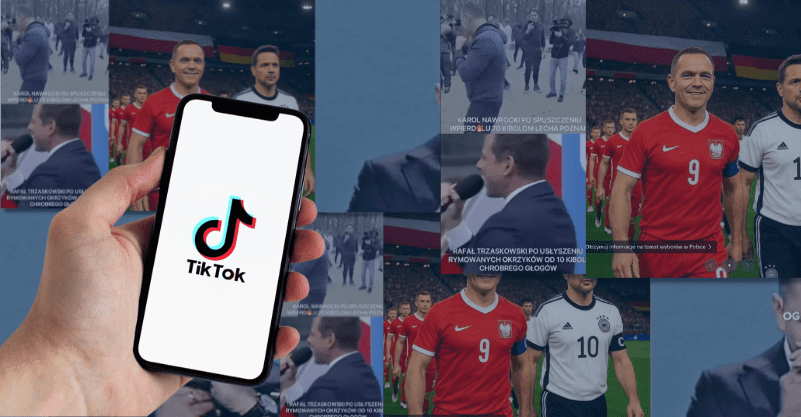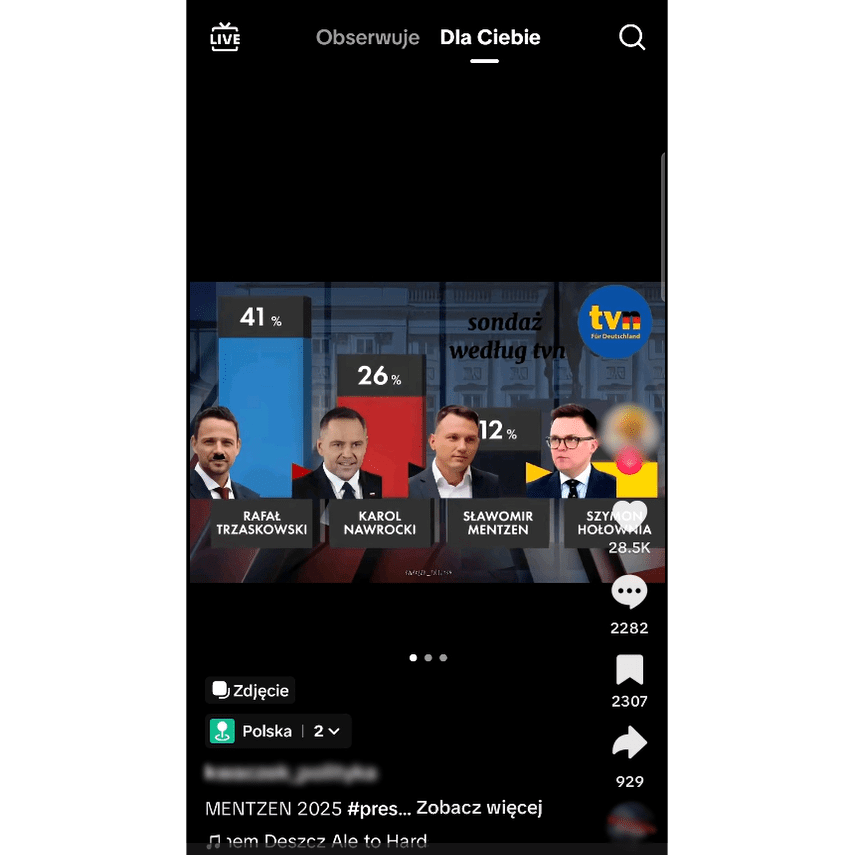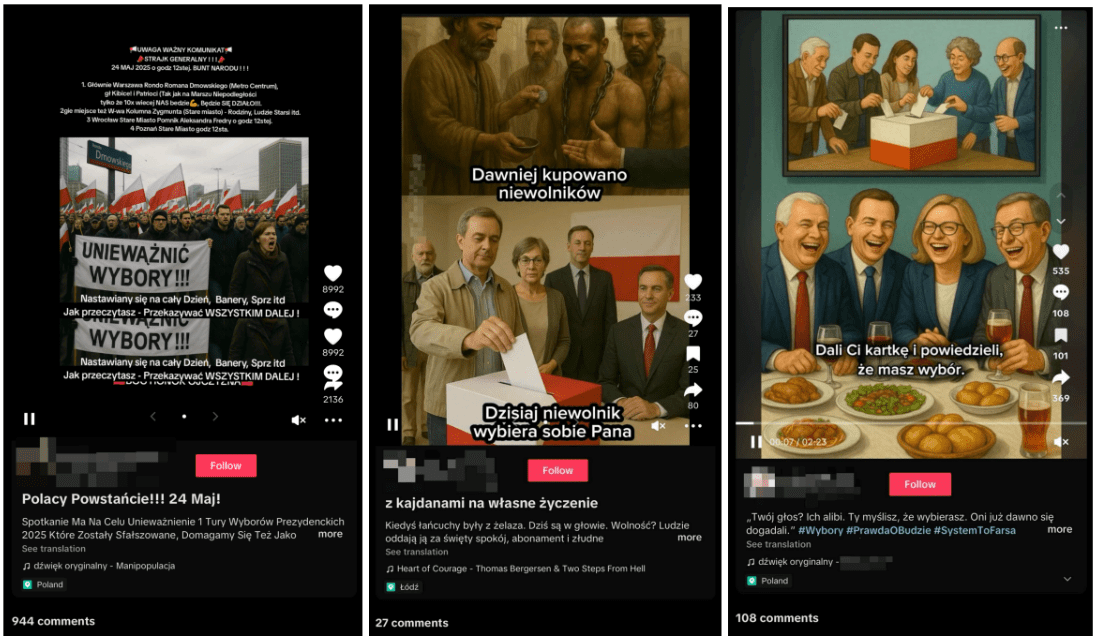Disinformation on Polish TikTok. Rigged elections and insults against Trzaskowski
Fake accounts attacking Rafal Trzaskowski, millions of views of videos undermining the integrity of the elections and a flood of right-wing content promoting Nawrocki – this is the landscape left by the presidential campaign on TikTok.

Fot. TikTok / Pixabay / Modyfikacje: Demagog
Disinformation on Polish TikTok. Rigged elections and insults against Trzaskowski
Fake accounts attacking Rafal Trzaskowski, millions of views of videos undermining the integrity of the elections and a flood of right-wing content promoting Nawrocki – this is the landscape left by the presidential campaign on TikTok.
TikTok was the main source of information about the presidential campaign among the youngest group of eligible voters (18-25 years old), according to a survey conducted by the UCE RESEARCH platform. During the election campaign period, TikTok was used most often by young voters of right-wing parties (Law and Justice and Confederation) and the Left. What social media content was displayed on their feed?
It turns out that TikTok in Poland – just as in Romania and Germany – had a tendency to promote far-right content and reinforced Law and Justice and Confederation voters in their beliefs. Furthermore, the display of content by Tiktok’s algorithm in this way may have influenced undecided voters.
TikTok’s algorith has a right-wing bias?
An analysis by the investigative organization Global Witness found that TikTok fed new users twice as much information with far-right or nationalist content as centrist and left-wing content on new accounts on the “For You” page.
What’s more, an analysis of the videos expressing support for Karol Nawrocki and Law and Justice, compared to those promoting Rafal Trzaskowski and his party, revealed a significant difference in reach. The first group of videos was shown to new TikTok users four times more often.

Source: Global Witness. Global Witness analysts have frequently seen posts that show Rafal Trzaskowski in a bad light. One example shows the Civic Coalition candidate with a drawn-on mustache resembling Adolf Hitler’s.
Within just 10 minutes of browsing, TikTok’s algorithms showed accounts – which had previously indicated equal interest in both candidates – over five times more videos positively portraying Nawrocki than those positively portraying Trzaskowski.
TikTok promotes emotional content
Global Witness’s findings do not offer clear evidence that TikTok’s algorithms were intentionally designed to promote right-wing content at the expense of centrist or left-leaning posts.
However, it is well known that social media platforms design their recommendation systems to capture and hold users’ attention for as long as possible. It is worth noting that right-wing content can often be more emotional, potentially attracting more engagement than more moderate, centrist narratives — such as that used in Trzaskowski’s campaign.
The prevalence of right-wing content on TikTok during the campaign might not have been entirely organic. This could suggest that some posts may have been created or boosted by inauthentic or fake accounts rather than real users.
Strong Nawrocki vs weak Trzaskowski
Findings from FactCheck.BY indicate that during the campaign, Karol Nawrocki’s own TikTok profile had fewer views (28.4 million) than Rafał Trzaskowski’s (37.2 million). The situation looks different when examining profiles not formally connected to the candidates.
Thanks to 42 inauthentic accounts, content related to Nawrocki generated 161.5 million views — more than 5.5 times the number of views of posts published on his official TikTok account.

Trzaskowski was portrayed as a “weak man from a big city.” In contrast, Karol Nawrocki was often depicted in videos as a strong man. There were also claims expressing the view that Rafał Trzaskowski pursues German interests, while Nawrocki is a true patriot
FactCheck.BY also detected over 1,200 accounts systematically criticizing Trzaskowski, alongside another 1,200 accounts endorsing Nawrocki or Mentzen. On the day before the first ballot, 171 new TikTok accounts appeared supporting Nawrocki, and on the voting day, another 205 profiles clearly favoring this candidate became active.
The accounts that became active just before the first round not only undermined Trzaskowski’s credibility and mobilized voters for Nawrocki and Mentzen, but also spread disinformation about the electoral process. More details were uncovered by the organization AI Forensics.
Disinformation about election fraud reaches millions of views
According to analysis conducted by AI Forensics, at least 23 videos, collectively gathered 4.3 million views, contained disinformation alleging fraud in the first round of elections. One of the highest-reaching videos suggested that certain individuals – particularly in major cities – cast multiple votes.
Nearly 80% of these misleading videos lacked election labels with attachments linking to credible information sources (18 of the 23 videos). TikTok had committed to redirect users to the Election Center page on which all election-related content should be available.
The AI Forensics team also found that the tab redirecting to the Election Center did not appear on videos if the user was not located in Poland. This means that approximately 20 million Poles living abroad were not directed by the platform to trustworthy election information.

Source: AI Forensics . TikTok posts with AI-generated images suggested or directly claimed that the Polish election was rigged. These posts did not include any labels indicating that the images were AI-generated.
4 out of 23 videos that used AI-generated images also lacked proper labeling. This not only violates TikTok’s policies but also highlights the platform’s ineffectiveness in enforcing its own rules. Although TikTok requires creators to tag AI content, the platform can also add a special label thanks to its detection system.
It’s not just a matter of Poland
Poland is not the only country where TikTok struggled to apply labels linking to the Election Center. An analysis conducted by the Institute for Strategic Dialogue showed that before the 2025 parliamentary elections in Germany, 45% of posts originating from official political party accounts or their fan pages lacked election-related labeling.
There are more similarities between Poland and Germany on this matter. It seems that disinformation about alleged election fraud has unfortunately become a permanent fixture on social media. During the campaign leading up to this year’s parliamentary elections in Germany, numerous false materials appeared aimed at undermining trust in democracy.
Some of these videos, such as those suggesting the absence of AfD candidates’ names on ballots, were part of the Storm-1516 operation carried out by Russian trolls. The same group also interfered in the U.S. presidential election process.
We reached out to TikTok’s spokesperson for comment. Our article is going to be updated once we receive an answer.
*If you find an error, highlight it and enter Ctrl + Enter


